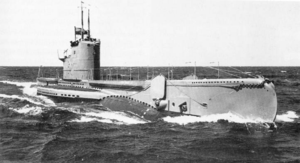EML Kalev
 EML Kalev | |
| Career (Estonia) | |
|---|---|
| Name: | Kalev |
| Operator: | Estonian Navy |
| Ordered: | 12 December 1934 |
| Builder: | Vickers and Armstrongs Ltd., United Kingdom |
| Laid down: | May 1935 |
| Launched: | 7 July 1936 13:20 |
| Commissioned: | 12 March 1937 |
| In service: | 1937–1940 |
| Out of service: | 1940 |
| Homeport: | Tallinn |
| Nickname: | Kalev |
| Captured: | by USSR in 1940 |
| Career (USSR) | |
| Name: | Kalev |
| Operator: | Soviet Navy |
| In service: | 1940 - 1941 |
| Out of service: | 1941 |
| Homeport: | Tallinn, Leningrad |
| Captured: | from Estonia in 1940 |
| Fate: | missing after 29 October 1941 |
| General characteristics | |
| Class and type: | Kalev class submarine |
| Displacement: | 665 tons surfaced 853 tons submerged |
| Length: | 59.5 m (195 ft 3 in) |
| Beam: | 7.5 m (25 ft) 7.5 m (24 ft 7 in) |
| Draught: | 3.6 m (12 ft) 3.6 m (11 ft 10 in) |
| Propulsion: | two diesel Vickers and Armstrongs Ltd. (1,200 hp (890 kW; 1,200 PS)) two Metropolitan-Vickers electric motors (790 hp (590 kW; 800 PS)) |
| Speed: | surfaced - 13.5 kn (15.5 mph; 25.0 km/h) submerged - 8.5 kn (9.8 mph; 15.7 km/h) |
| Test depth: | 120 m (390 ft) |
| Complement: | 4 officers + 28 sailors |
| Armament: | 4 × 21 in (530 mm) torpedo tubes (bow, 8 torpedoes) 1 × 40mm Bofors AA gun 1 × 7.7 mm Lewis AA machine gun 24 mines |
EML Kalev was one of two submarines of the Republic of Estonia launched in 1936 at Vickers and Armstrongs Ltd. in England. Her sister, Lembit, survived the Second World War.
History
The Kalev was the second pre-war Estonian Navy submarine. Estonia is a maritime nation and, as every country with a long coastline, has to defend and safeguard its territorial waters. With due regard to the experiences of World War I, the submarines found their proper application in the pre-Second World War Estonian Navy. The collection organised by the Submarine Fleet Foundation in May 1933 developed into one of the most successful undertakings among the similar events demonstrating a nationwide determination to defend one’s country.
In the course of building and testing two submarines, the Estonian crews got a top-level naval training of the time in England in 1935–1937. In the period of 1937–1940 the submarines Lembit and Kalev were the most imposing naval vessels of the Estonian Navy. Their non-interference upon annexation of Estonia by the USSR was a political decision made irrespective of the will of the navy.[1]
Kalev in World War II
The submarine Kalev joined the Estonian Navy in spring 1937, where she operated until the Soviet takeover in 1940. (On 24 February 1940, The Third Reich had expressed its interest in obtaining the submarine, if Estonia would sell it, but this offer was turned down.)
Service in the Soviet Navy
The submarine was formally taken over by the Soviet Navy on 18 September, 1940, by which only five men of the submarine crew remained in place, to instruct the new Soviet crews. After the outbreak of the German-Russian war in June 1941, Kalev was re-complemented, having a totally Russian-speaking crew, although the original name Kalev was retained. During the Second World War the Kalev participated in military operations among the vessels of the Soviet Baltic Fleet. Kalev did not return from her second patrol and was reported as missing since 29 October 1941.[2]
Possible wreck
Kalev’s ultimate fate or the location of the wreck was unknown for a long time (it was usually assumed that she hit a mine and sunk off Keri in the Gulf of Finland between Tallinn and Helsinki, but she could have been anywhere between Kronstadt and Hanko; some sources suggested she was scuttled in the Tallinn Bay during the Soviet evacuation on 28 August 1941).
In June 2010, an Estonian Maritime Museum research team concentrated their efforts on finding Kalev. It was assumed that Kalev hit a mine and sunk at a minefield off Cape Juminda.[3] On 30 June 2010 a wreck of a submarine was found five miles north of Cape Juminda, Northern Estonia by the Estonian Maritime Museum research vessel Mare. According to marine archeologist Vello Mäss, the specific shape of mine shafts of the submarine seen on the sonar screen indicate a probability of about 95% that the wreck found is Kalev. Further research is needed to confirm the finding.[4]
The finding of the research vessel Mare suggests the high probability that Kalev has been found and she sank as a result of hitting a mine near Cape Juminda. [5]
Later it was discovered that despite the wreck looking like a submarine, it turned out to be an old aerostat. The Kalev is still missing.
References
External links
| Wikimedia Commons has media related to Submarine Kalev. |